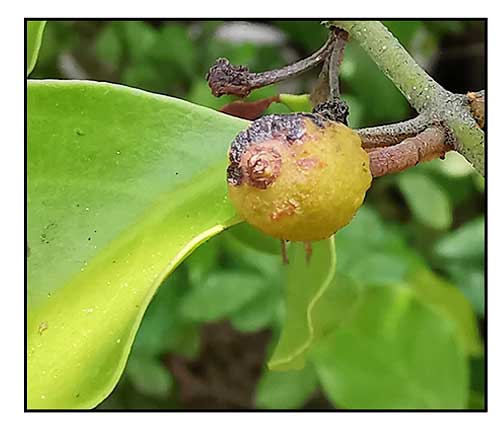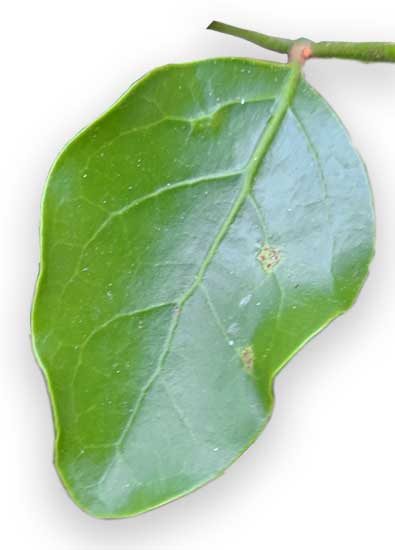 Gen info Gen info
-
Taxillus is a plant genus in the mistletoe family, Loranthaceae.
- Taxillus chinensis is a species of flowering plant in the family Loranthaceae, first scientifically described by Danser in 1938.
- Etymology: The genus name Taxillus mean little dice, probably referring to the fruits. The specific epithet chinensis refer to China as a place of origin.
Botany
• Growth form: Parasitic shrub, able to grow up to 0.5 - 1 m in length. Foliage: Opposite green leaves, ovate to ovate-oblong, measuring about 2.5 - 6 by 1.5 - 4 cm, both surfaces becoming smooth as leaves mature, leaf margins reddish brown, leaf stalk measuring about 8 - 10 mm long. Flowers: Tubular, curved flowers, usually 2 - 4 in an umbel, peduncle measuring about 2 - 4 mm, stellate hairy, bracts triangular in shape, pedicel measuring about 6 - 7 mm, ovoid calyx, style red in colour. Fruit: Ellipsoid berry yellow in colour, measuring about 8 - 10 by 5 - 6 mm, surface becoming smooth as fruit matures. (Flora & Fauna Web)
 • A hemi-parasitic shrub that grows to a height of 0.5–1 m. It is usually distributed in plains or low-mountain evergreen broad-leaved forests at altitudes of 20–400 m. Branchlet and leafage: densely covered with brown or reddish-brown stellate hairs, sometimes with scattered or stacked stellate hairs. Branchlets were black and glabrous. Leaves are nearly opposite or alternate, leathery, ovate, long ovate or elliptic, 5–8 cm long, 3–4.5 cm wide, apex obtuse, base suborbicular, glabrous on top, tomentose on the bottom; lateral veins in 4–5 pairs, leaf veins are obvious; petioles 6–12 mm long, glabrous. Flowers: racemes are borne in the leaf axils or leaf axils of twigs, with 2 to 5 flowers, the inflorescence is corymbose, inflorescences and flowers are densely covered with brown stellate hairs; peduncle and rachis 1–3 mm long, pedicels 2–3 mm long; bracts ovate-triangular, 4-toothed; corolla flower bud is tube-shaped, 2.2–2.8 cm long, slightly curved, distend swollen, apically elliptic, lobes 4, lanceolate, 6–9 mm long, reflexed, sparse hair after anthesis; filaments approximately 2 mm long, anthers 3–4 mm long, another room often has a diaphragm, and the stigma is conical. Fruits: elliptical, yellow–green, with granular skin. (4) • A hemi-parasitic shrub that grows to a height of 0.5–1 m. It is usually distributed in plains or low-mountain evergreen broad-leaved forests at altitudes of 20–400 m. Branchlet and leafage: densely covered with brown or reddish-brown stellate hairs, sometimes with scattered or stacked stellate hairs. Branchlets were black and glabrous. Leaves are nearly opposite or alternate, leathery, ovate, long ovate or elliptic, 5–8 cm long, 3–4.5 cm wide, apex obtuse, base suborbicular, glabrous on top, tomentose on the bottom; lateral veins in 4–5 pairs, leaf veins are obvious; petioles 6–12 mm long, glabrous. Flowers: racemes are borne in the leaf axils or leaf axils of twigs, with 2 to 5 flowers, the inflorescence is corymbose, inflorescences and flowers are densely covered with brown stellate hairs; peduncle and rachis 1–3 mm long, pedicels 2–3 mm long; bracts ovate-triangular, 4-toothed; corolla flower bud is tube-shaped, 2.2–2.8 cm long, slightly curved, distend swollen, apically elliptic, lobes 4, lanceolate, 6–9 mm long, reflexed, sparse hair after anthesis; filaments approximately 2 mm long, anthers 3–4 mm long, another room often has a diaphragm, and the stigma is conical. Fruits: elliptical, yellow–green, with granular skin. (4)
 Distribution Distribution
- Native to the Philippines. (1)
- Also native to Borneo, Cambodia, China Southeast, Hainan, Laos, Malaya, Thailand, Vietnam. (1)
Constituents
- To date, about 110 compounds have been identified in T. chinensis, including flavonoids, phenolic acids, phenylpropanoids, tannins, glycosides, amino acids, and nucleosides. (4)
- Study of branches and leaves of T. chinensis isolated four new hemiterpenoid derivatives, taxilluside A-D (1-4). (see study below) (10)
Properties
- Studies suggest anti-osteoporosis, anti-obesity, fatty acid synthase inhibitory, anti-SARS CoV-2 replication, antihyperuricemic, antioxidant, immunomodulatory, antiproliferative, anti-osteoarthritis properties.
Parts used
Leaves.
 Uses Uses
Edibility
- In Guagdong and Guangxi, China, stems and buds used for making tea. (4)
- Dried stems, and leaves
used in preparing soups.
-
Caution: Potential toxicity depends on host plant it parasitizes. (see study below) (1)
Folkloric
- No reported folkloric medicinal use in the Philippines.
- In traditional Chinese medicine, used for dispelling wind dampness, strengthening bones and muscles, and preventing miscarriage. Since Eastern Han Dynasty, it has been used for treatment of rheumatoid arthritis, arthralgia, threatened abortion, and hypertension. In 2020, it was included in the Edition of the Chinese pharmacopoeia as Taxilli Herba. (4) Dried branch with leaf used to dilate the coronary artery, lower blood pressure, and for diuretic and anti-tumor effect. (11)
- Women in the Lignan region of China use T. chinensis to make soups and tea for pregnancy preservation and postpartum rehabilitation. (4)
Studies
• Host-Related Toxicity: Reports on toxicity are mainly related to liver and embryo toxicity. Toxicity is closely related to the host. During growth and development, the host transfers characteristic components of T. chinensis, and if the components are toxic, they will affect the safety of T. chinensis. In a study on zebra fish using water extracts of T. chinensis from six different hosts, five showed a certain degree of liver damage in zebrafish. T. chinensis from M. alba showed no hepatotoxicity. In a study for safe dosage of drugs, T. chinensis has certain genetic toxicity at 40g/kbw. Potential for embryonic development toxicity was observed at 40 g/kbw. No teratogenic effect was observed in rat embryos. While no teratogenic effect was observed in rat embryo, high-dose decoction showed embryo toxicity. (4)
• Flavonoids from Different Hosts / Morus Alba: A metabolomic study using UPLC-MS identified and compared the main biomarkers and flavonoid metabolites of Taxillus chinensis growing on different hosts. Total flavonoids of T. chinensis (up to 30.08 mg/g) from Morus alba(CSG) was significantly higher than growth on Liquidambar formosana or Clausena lansium. Results demonstrated that different hosts exerted a large influence on metabolites of T. chinensis. Differences in hosts can influence the type and abundance of flavonoids in parasitic plants such as Taxillus chinensis. Plants grown on Morus alba offer the greatest potential for development of new anti-cancer drugs. (5)
• Protective on Ovariectomy-Induced Osteoporosis: Study evaluated the protective effect of aqueous extracts of T. chinensis (AETC) on ovariectomy (OVX)-induced osteoporosis in rats. Results showed AETC at dose of 12.0 g raw materials/kg for 12 weeks significantly enhanced bone mineral densities of femur and tibia, improved trabecular microarchitecture compared to OCX controls. Serum levels of osteogenic markers alkaline phosphatase and osteocalcin were increased, and levels of bone resorption biomarkers tartrate-resistant acid phosphatase 5b and telopeptides of collagen type 1 were suppressed. Treatment also significantly reduced the OVX-induced up-regulation of COX-2 mRNA and protein expression in bone tissue. Study suggested the anti-osteoporotic effect in OVS rats is possibly via promotion of bone formation and inhibition of bone resorption. Down-regulation of inflammatory COX-2 may be involved in the protection of AETCs against OVX-induced osteoporosis. (6)
• Anti-Obesity / Inhibition of Fatty Acid Synthase: Previous study has shown one of species of parasitic Taxillus chinensis exhibited potent inhibition of fatty acid synthase (FAS), a proposed therapeutic target for treatment of obesity. Study evaluated parasitic loranthus from two families. Result showed parasitic T. chinensis could reduce body weight and appetite in mice possibly through inhibiting FAS. (7)
• Immunomodulatory Polysaccharides from T. chinensis and Uncaria rhyncophylla / Stems: Study isolated polysaccharides from stems of T. chinensis and stems with hooks of U. rhyncophylla. Results showed some of the isolated fractions (TCP-2, TCP-3, UC-1 and UC-2) exhibited significant antioxidant activities and were found to be effective immunomodulators in a concentration-dependent manner. Results suggest therapeutic potential for the treatment of cancer. (8)
• Cardiac Glycosides in Parasites T. chinensis and S. parasitica and Host Nerium indicum: Study evaluated the effect of host plant on the quality of Loranthaceae species as medicinal raw material using UPLC-Q-TOF-MS/MS to identify cardiac glycosides in Nerium indicum and its parasitic plants species Taxillus chinensis and Scurrula parasitica. A total of 25 cardiac glycosides were identified, 28 of which were found in N. indicum parasitized by T. chinensis. N. indicum will transfer its own cardiac glycosides to its parasites through a special host-parasite interaction. Study provides reference basis on influence of host plant on the quality of medicinal compounds from Loranthaceae species. (9)
• Hemiterpenoid Derivatives / Inhibition of Calcium in Myocardial Cells / Branches and Leaves: Study of branches and leaves of T. chinensis isolated four new hemiterpenoid derivatives, taxilluside A-D (1-4). Compounds 3 and 4 showed inhibition activity on calcium concentration in myocardial cells. (10)
• Inhibition of SAR-CoV Replication: Study evaluated more than 200 extracts from Chinese medicinal herbs for anti-SARS-CoV activities using cell-based assay that measured SARS-CoV-induced cyto-
pathogenic effect (CPE) in vitro on Vero E6 cells.
Six herbal extracts, including dried stem and leaf of Taxillus chinensis, were found to be potent inhibitors of SARS-CoV at concentrations between 25 and 200 µg/mL. Taxillus chinensis showed selective index value (SI=CC50/EC50) of >92.9. Results suggested the six herbal extracts as potential candidates for future development of anti-SARS therapeutics. (11)
• Anti-Proliferative in Human Colorectal Cancer Cells: Study evaluated the anticancer and potential molecular mechanism of 70% ethanol extracts from Taxilli Ramulus (Taxillus chinensis) (TR-E70) against human colorectal cancer cells. Antiproliferative effect of TR-E70 was evaluated by MTT assay. TR-E70 suppressed proliferation of human colorectal cancer cell lines, HCT116 and SW480. Cyclin D1 down-regulation by TR-E70 was attenuated in the presence of MG132. Results suggest TR-E70 may down-regulate cyclin D1 as one of the potential anticancer targets through $GSK3{\beta}$-dependent cyclin D1 degradation. Results suggest TR-E70 has potential as candidate for development of chemoprevention or therapeutic agents for human colorectal cancer. (12)
• Antibacterial: Study evaluated the antibacterial effect and mechanism of T. chinensis. Results showed antibacterial effect with the ethyl acetate extract showed best effect. Its active component, 4-indolecarb-aldehyde showed broad-spectrum antibacterial effect. Study suggests the antibacterial mechanism of T. chinensis and 4-indolecarbaldehyde is related to the changes in bacterial membrane permeability. (13)
• In the News: Treatment of Hyperuricemic Nephropathy: Taxillus chinensis is broadly used in traditional Chinese medicine. Pharmacological research showed an ethyl acetate extract of T. chinensis has beneficial effects in treating hyperuricemic nephropathy, the active components and potential mechanisms for the effects remain unclear. (14)
• Fatty Acid Synthase Inhibition / Avicularin: A previous study showed parasitic loranthus was found to inhibit fatty acid synthase (FAS) rand reduce body weight in rats. Study determined the inhibitory characteristics and kinetic parameters of extracts of parasitic loranthus (Taxillus chinensis). Parasitic loranthus extracts (PLE) inhibits FAS reversibly and irreversibly and with IC50 of 0.48 µg/ml appears to be the most potent inhibitor reported to date. The irreversible inhibition is a time-dependent biphasic process including a fast phase inhibition in the initial minutes. Avicularin was found existing in the herb, which can potently inhibit FAS. This glycosylated flavonoid and quercetin played an effective role in the inhibition of FAS by parasitic loranthus. The high inhibitory potency of PLE on FAS and its weight-reducing effects suggest a potential for parasitic loranthus as an anti-obesity drug. (15)
• Protective Against Monosodium Iodoacetate-Induced Osteoarthritis: Study evaluated the protective effects of an aqueous extract from T. chinensis (TCE) in monosodium iodoacetate (MIA)-induced osteoarthritis rat model. Results showed TCE recovered the hind paw weight bearing distribution, inhibited production of inflammatory cytokine, and protected synovial tissue and cartilage in the OA rat model. Study suggests TCE is an effective therapeutic agent for treating OA and OA-related symptoms. (16)
Availability
- Wild-crafted.
- Extracts, tinctures, powders in the cybermarket. |

![]()







